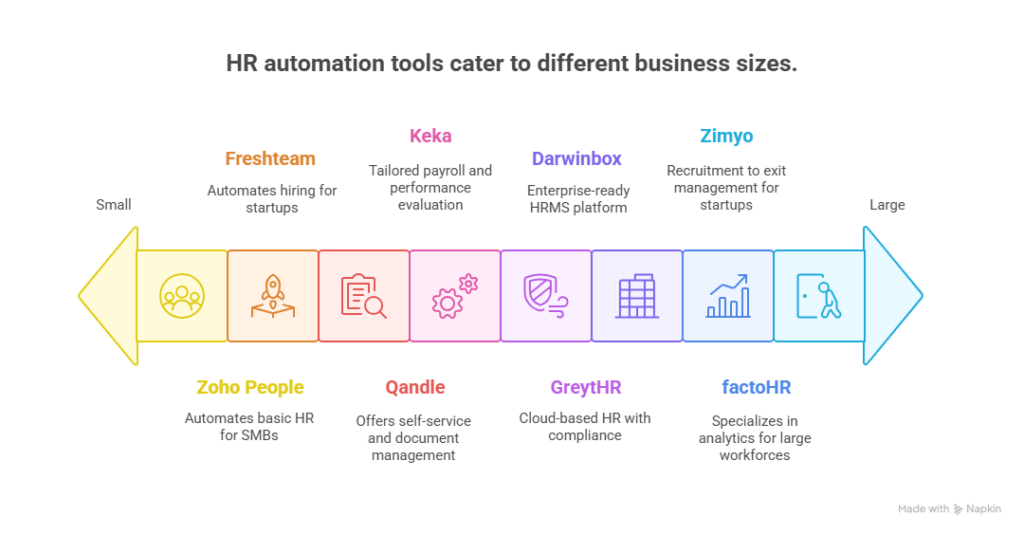
Why HR Automation Will Save You Time and Money in 2025
- by Indu Sharma
Everything from recruitment and onboarding to payroll, compliance, and employee engagement. As we move deeper into the digital age, traditional HR processes are increasingly being replaced by automated solutions. In 2025, this shift is not just a trend it’s a necessity. Companies in India are rapidly adopting HR automation tools India 2025 to enhance efficiency, reduce costs, and improve employee satisfaction.
This article explores the transformative power of human resources automation, detailing the key benefits, popular tools, industry-specific use cases, and future trends.
What is HR Automation?
Human resources automation refers to the use of digital tools and technologies to automate repetitive HR tasks, streamline workflows, and improve accuracy. These tools handle a wide range of functions such as resume screening, interview scheduling, attendance tracking, payroll processing, and compliance management.
Why HR Automation Matters in 2025
The HR landscape has evolved dramatically over the past decade, and 2025 marks a turning point. Businesses, especially in India, are under immense pressure to remain agile, competitive, and compliant in a fast-paced environment. HR automation helps in:
- Reducing manual errors
- Improving decision-making
- Accelerating HR processes
- Enhancing the candidate and employee experience
- Ensuring legal and regulatory compliance
In addition, the pandemic and remote work revolution have emphasized the need for HR to become more resilient and responsive. Automation supports a distributed workforce and minimizes administrative workload.
HR automation also provides deep insights through analytics, helping organizations forecast hiring needs, monitor employee engagement, and track compliance issues in real-time. This strategic advantage becomes critical for HR departments transitioning from an operational role to a business-impacting function.
Top HR Automation Tools India 2025
Several powerful tools are leading the HR automation revolution in India. These platforms offer modular and scalable solutions that suit companies of all sizes and sectors.

-
Darwinbox
An enterprise-ready HRMS platform designed for Indian businesses. Automates everything from hiring to performance reviews.
-
Zoho People
Ideal for small to medium-sized businesses, Zoho People automates attendance, leave, and onboarding processes.
-
Keka
Offers payroll management, performance evaluation, and employee tracking features tailored for the Indian market.
-
GreytHR
Provides cloud-based HR and payroll automation with statutory compliance tailored to Indian regulations.
-
Freshteam by Freshworks
Best for fast-growing startups and SMEs. Helps automate hiring, onboarding, and employee data management.
-
Qandle
A modern HR software that offers employee self-service, document management, and automated workflows.
-
factoHR
Specializes in attendance, payroll, and performance analytics, suitable for enterprises with a large workforce.
-
Zimyo
Another rising HR automation platform offering everything from recruitment to exit management, ideal for fast-scaling Indian startups.
Benefits of HR Automation
-
Time Efficiency
HR professionals spend countless hours on repetitive tasks. Automation frees up time for strategic initiatives like workforce planning and talent development.
-
Cost Savings
Automated tools reduce the need for extensive HR teams and eliminate costly errors in payroll and compliance.
-
Improved Accuracy
Mistakes in HR operations can be costly and damaging. Automation ensures accurate and timely processing of data.
-
Enhanced Employee Experience
Automated self-service portals improve employee satisfaction by providing easy access to personal data, leave requests, and payslips.
-
Compliance and Audit Readiness
With ever-changing labor laws and regulations in India, automation ensures that companies stay compliant without constant manual oversight.
-
Scalability
As companies grow, automated systems adapt more efficiently than manual processes. Whether scaling from 50 to 5,000 employees, automation maintains consistency.
-
Improved Communication
Integrated platforms ensure timely alerts, feedback loops, and documentation delivery, eliminating information silos.
-
Better Employee Retention
Automated engagement surveys and AI-powered feedback tools can help identify at-risk employees and improve job satisfaction.
-
Real-Time Decision Making
With dashboards and analytics, HR teams can take action based on current data rather than monthly or quarterly reviews.
-
Integration with Broader Business Systems
Modern HR tools integrate with finance, project management, and CRM platforms, enabling holistic business intelligence and performance alignment across departments.
-
Environmental Sustainability
By reducing paperwork and enabling digital documentation and communication, HR automation supports green business practices, which is increasingly important for both compliance and corporate reputation.
Use Cases of Human Resources Automation in 2025
Recruitment and Onboarding
AI-based resume screening tools filter candidates based on keywords and job requirements. Once selected, candidates receive automated onboarding emails, documents, and training modules.
Attendance and Leave Management
Biometric systems integrated with automation platforms automatically record attendance. Leave applications are routed and approved without HR intervention.
Payroll and Benefits Administration
Automated payroll tools calculate salaries, generate payslips, deduct taxes, and transfer funds all without manual input.
Performance Management
Annual reviews are becoming obsolete. Real-time performance tracking and feedback through automation tools enhance employee development.
Learning and Development
Customized training recommendations powered by AI help employees stay updated with new skills and compliance requirements.
Offboarding
Automated workflows ensure timely revocation of access, settlement of dues, and collection of feedback from outgoing employees.
Compliance Reporting
Automated alerts and reporting templates help HR teams stay ahead of audits, legal changes, and industry certifications.
Internal Mobility
AI-driven internal job matching can help redeploy talent internally, reducing external hiring costs and improving morale.
Challenges in Implementing HR Automation
Despite the benefits, HR automation is not without its challenges:
- Initial investment costs
- Change management and employee resistance
- Data security and privacy concerns
- Integration with existing systems
Companies need a clear strategy and expert guidance to transition smoothly.
To address resistance, communication and training are critical. HR leaders must clearly explain how automation enhances not replaces human roles.
HR Automation Trends to Watch in 2025
-
AI-Powered Chatbots
Chatbots will manage basic HR queries 24/7, freeing human HR teams for complex tasks.
-
Predictive Analytics
Data-driven insights will help HR predict turnover, identify high-potential employees, and improve retention.
-
Blockchain in HR
Blockchain will ensure secure, tamper-proof storage of employee records and credentials.
-
Remote Work Support
Tools will be geared to support hybrid and remote work models, including virtual onboarding and remote team engagement.
-
Personalized Employee Experiences
Using data and AI, HR automation tools will deliver customized experiences based on employee roles, preferences, and career paths.
-
Voice and NLP Interfaces
Voice-enabled HR interactions and Natural Language Processing (NLP) will make systems easier to use and more intuitive.
-
Robotic Process Automation (RPA) Expansion
RPA will be more deeply embedded across recruitment, payroll, and compliance checks.
-
Low-Code Platforms
HR teams will be able to build custom workflows using low-code/no-code platforms without needing IT support.
-
DEI Automation
Automated tools will help track and enhance diversity, equity, and inclusion (DEI) initiatives.
-
Hyper-Automation
Combining AI, ML, RPA, and analytics into a single, interconnected system to create a fully automated HR environment.
Strategic Approach to HR Automation
Step 1: Conduct an HR Audit
Identify repetitive, time-consuming, and error-prone tasks.
Step 2: Select the Right Tools
Choose platforms that align with your business size, industry, and workforce needs.
Step 3: Pilot Implementation
Start with one or two processes to test effectiveness.
Step 4: Train HR Teams and Employees
Ensure everyone is comfortable using the new systems.
Step 5: Scale and Optimize
Gradually expand automation across HR functions and collect feedback for improvement.
Step 6: Measure ROI
Track performance indicators such as reduced processing time, error rates, and employee satisfaction to evaluate success.
Case Study: HR Automation Success in Indian IT Firm
A mid-sized IT services company in Bangalore implemented Keka and Zoho People in phases. Within 6 months, they:
- Reduced payroll errors by 90%
- Cut onboarding time from 2 weeks to 2 days
- Improved employee satisfaction scores by 25%
The company saved ₹1.5 crores annually on HR operations by eliminating inefficiencies and human error.
They also reported a 40% improvement in HR response time to internal queries and a 70% reduction in paperwork.
Future of HR Automation in India
India’s young, tech-savvy workforce is driving demand for better workplace experiences. Combined with government pushes for digital transformation, HR automation tools India 2025 will become the norm, not the exception. Organizations that fail to adapt may face talent attrition, regulatory penalties, and falling behind the competition.
Startups and SMEs in Tier 2 and Tier 3 cities are also joining the automation wave thanks to SaaS-based solutions that are affordable and easy to implement. From educational institutions to logistics providers, HR automation is going beyond traditional white-collar domains.
Universities and training institutes are integrating HR tech education into their curricula, ensuring that tomorrow’s HR professionals are automation-ready. Meanwhile, government initiatives like Digital India and labor law reforms further encourage adoption.
As the landscape continues to evolve, companies investing in human resources automation will benefit from improved agility, greater transparency, and an enhanced employer brand. It’s not just about saving time or money it’s about building a sustainable HR foundation ready for the challenges of the next decade.
Conclusion
In 2025, adopting HR automation tools in India is no longer optional it’s essential for staying competitive, reducing overhead, and improving the overall employee experience. Whether you’re a startup or an enterprise, human resources automation helps streamline hiring, onboarding, payroll, compliance, and performance management saving time and money across the board.
The future of work is digital, and businesses that embrace automated HR solutions today will lead tomorrow. Don’t get left behind.
Partner with Mount Talent Consulting Pvt. Ltd. to design and implement tailored HR automation strategies that align with your business goals. Our experts help you choose the right tools, manage the transition smoothly, and unlock the full potential of your workforce.
Start your automation journey today. Future-proof your HR function with Mount Talent.
Frequently Asked Question
Q1. What are the top HR automation tools India 2025 companies are using?
Top tools include Darwinbox, Keka, Zoho People, GreytHR, and Freshteam. These tools automate key HR processes and are tailored for Indian businesses.
Q2. Can HR automation replace human HR teams?
No, it enhances their efficiency. Automation handles repetitive tasks so HR professionals can focus on strategic functions like talent management and employee engagement.
Q3. Is HR automation secure for handling sensitive employee data?
Yes. Most modern HR automation platforms offer robust encryption, data access controls, and compliance with Indian data privacy laws.
Everything from recruitment and onboarding to payroll, compliance, and employee engagement. As we move deeper into the digital age, traditional…
